Australian Aboriginal rock art may be the oldest Stone Age art on the planet. This possibility is supported by the studies of Professor Stephen Oppenheimer, whose research combines genetic analysis with climatology, archeology, fossil analysis and modern dating methods, in order to juxtapose early migration with early rock art.
According to Oppenheimer, modern humans first began arriving in Australia from islands across the Timor Sea during the Middle Paleolithic era, between 70,000 and 60,000 BCE. Evidence of the ancient art (if any) of this first wave of aboriginal settlers is extremely scarce, but there are signs of pigment usage which suggest that they began painting almost immediately, although this might have been face or body painting rather than rock painting.
In any event, human occupation in Australia has been carbon-dated to at least 53,000 BCE, and the oldest Australian human fossil has been dated to around 38,000 BCE – the difference probably being due to the drowning of the earliest coastal occupation sites by rising sea-levels: a phenomenon known to Europe through the Cosquer Cave paintings, near Marseilles.
All this means that aboriginal migrants were settled in Australia some 10,000 years before their northern counterparts arrived in Europe. So we may yet discover that Paleolithic art in Australia predates the cave art in Europe by a similar margin.
The 2011 discovery of the Nawarla Gabarnmang charcoal drawing (dated to 26,000 BCE) in the north of the country is a step in this direction, but the rock paintings in the Kimberley region of Western Australia – as well as UNESCO listed sites at Uluru and Kakadu in the Northern Territory, Kimberley and the Burrup (Murujuga) Peninsula in Western Australia – are also under investigation by researchers using the latest dating methods, including thermoluminescence as well as Uranium-Thorium (U/Th) and cosmic radiation techniques. Other, possibly even older examples of prehistoric art (cupules) have been discovered in the granite rock shelter of Turtle Rock, Northern Queensland, and in the dark limestone caves of southern Australia.
Australian Aborigine artists have continued to practice their traditional arts and crafts into the modern era, creating in the process a unique and unbroken record of artistic expression. Unfortunately, over time, some aboriginal caves and rock shelters have become saturated with superimposed imagery as well as artifacts from a great many occupations. As a result, even though Australia is home to more petroglyphs and pictographs than any other country in the world, the sheer number of these cave paintings and rock engravings places a heavy burden on the country’s limited archaeological resources.
READ MORE: Terracotta fragments of the Lapita people
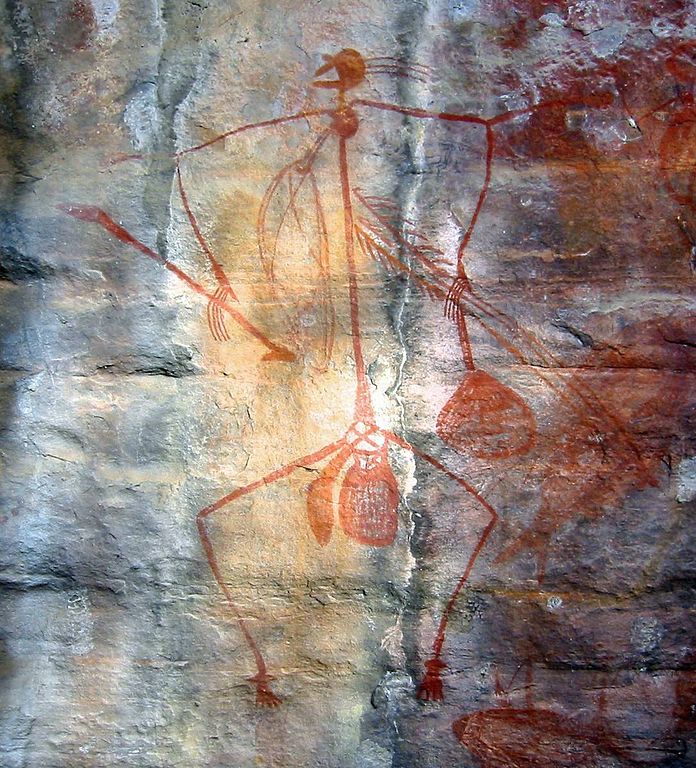
Aboriginal Art Types
Australian aboriginal art encompasses works in a diverse range of media. As well as rock engravings and cave painting, it includes various forms of prehistoric sculpture.
Aboriginal rock painting includes at least five different styles:
- X-ray and cross-hatch art from the Arnhem Land and Kakadu regions of Northern Australia – a style of painting in which the insides of animals and humans are depicted, as if X-rayed.
- Dot-painting from areas in Central and Western Australia – featuring a range of complex patterns, created with dots.
- Stencil painting from several different locations, featuring negative stencils and positive prints of hands and feet.
- Bradshaw paintings (now called Gwion art) – originally named after the European livestock farmer Joseph Bradshaw – from the Kimberley region of Western Australia. They include ‘sash paintings” made with pigments painted on rock surfaces by feather quills.
- Face painting, and other traditional forms of tribal art practised by aboriginal artists throughout Australasia, such as the Yolngu people of Arnhem Land.
- Various types of painting on leaves, bark and baobab seeds. Strangely, ancient pottery does not appear to have been made in Australia.
Another form of Australian prehistoric art involves megaliths, and features large and small stone circles (like Stonehenge) associated with ceremonial events. In New South Wales, a number of aboriginal cylindro-conical stone implements (cyclons) have been discovered, dating to 18,000 BCE.
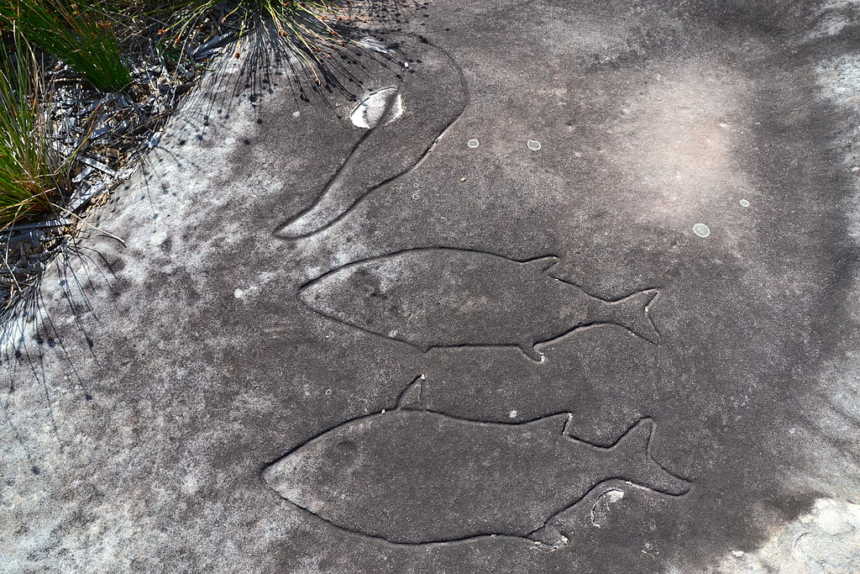
Finally, Australia is also home to numerous prehistoric cupules – the mysterious cultural markings found throughout the world.
The colour pigments used by aboriginal painters were obtained from mineral sources (eg. ochre pits, charcoal, clay, chalk), fruits (berries), vegetables (eg. carrot juice or equivalents), and animal blood and urine.
Characteristics of Aboriginal Art
Australian aboriginal art encompasses figure painting, as well as forms of abstract art. Characteristic of the Northern Territory are the so-called “X-ray” drawings – a special variety of stick-figures of animals and humans, in which the artist represents the inner parts of the body because he knows they are there, and is particularly interested in them.
The same style occurs in Oceanic art of Melanesia, and the Australian examples may be due to Melanesian influence. But X-ray drawings are also seen on the other side of the Pacific, among the Indians of British Columbia and some of the Eskimo tribes of Alaska.
Aboriginal abstract paintings may include a variety of concentric circles, arcs, dots and other pictographs that are intended to convey information.
Knowledge of aboriginal culture is a key factor in understanding whether a work of art is abstract or representational. For instance, a number of round designs about an inch in diameter – which students without such knowledge might have taken for simple motifs of non-objective art – have been ascertained by historians to represent a green plum-like fruit, called nalge. The regular supply of this fruit is maintained by painting representations of it on rocks during the wet season.
The meaning of symbols used in Aboriginal Stone Age art may vary with locality and region. A simple circle, for instance, may denote a campfire, tree, waterhole or hill, according to which Aboriginal tribe you belong to. Note also that a good deal of prehistoric imagery in Australia – whether naturalistic or abstract – is based on the aboriginal cultural concept of Dreamtime. In fact, most traditional Aboriginal art has some sort of mythological or spiritual content.

Aboriginal Art – Dating
Due to technical issues, problems of scale and lack of resources, archaeologists have so far been unable to confirm the strong suspicions of the scientific community that Australia contains the world’s oldest art.
The argument in favor is quite straightforward. Modern man arrived in Europe around 45,000 BCE and almost immediately (within about 5,000 years) started to produce art. But modern man arrived in Australia at least 10,000 years earlier, suggesting that he created his art earlier, too.
Note that the earliest Aboriginal caves and rock shelters were probably lost as sea levels rose, so the first human migrants – as Professor Oppenheimer claims – may have arrived even earlier, between 70,000 and 60,000 BCE. If so, it is perfectly possible that Stone Age art first appeared in Australia well before 50,000 BCE. After all, modern man was creating primitive art in Africa at least 70,000 years ago so the artistic urge had already emerged.

History/Chronology of Oldest Known Aboriginal Art
Here is a small selection of the oldest art in Australia. As stated above, it is quite possible that new discoveries will be made of even earlier art dating back to 40,000-50,000 BCE.
• Ubirr Aboriginal Rock Art (c.30,000 BCE) Arnhem Land, Northern Australia.
• Burrup Peninsula (Murujuga) Rock Carvings (30,000 BCE) Western Australia.
• Bradshaw Sash Painting (c.17,000 BCE) Kimberley, Western Australia.
• Cylindro-conical Stone Implements (cyclons) (c.17-18,000 BCE) NSW.
• Sydney Rock Engravings (c.5000 BCE) NSW.
Ubirr Aboriginal Rock Art
The earliest art in Australia is found at Ubirr in Arnhem Land, Northern Australia. Ubirr, situated in the Kakadu National Park in the Northern Territory, consists of a group of rock faces on the fringes of the Nadab floodplain. Ubirr’s art is commonly divided into three periods: Pre-Estuarine (c.40,000–6,000 BCE), Estuarine (c.6000–500 CE), and Fresh Water (c.500–present) – categories based on the style and iconography of the images.
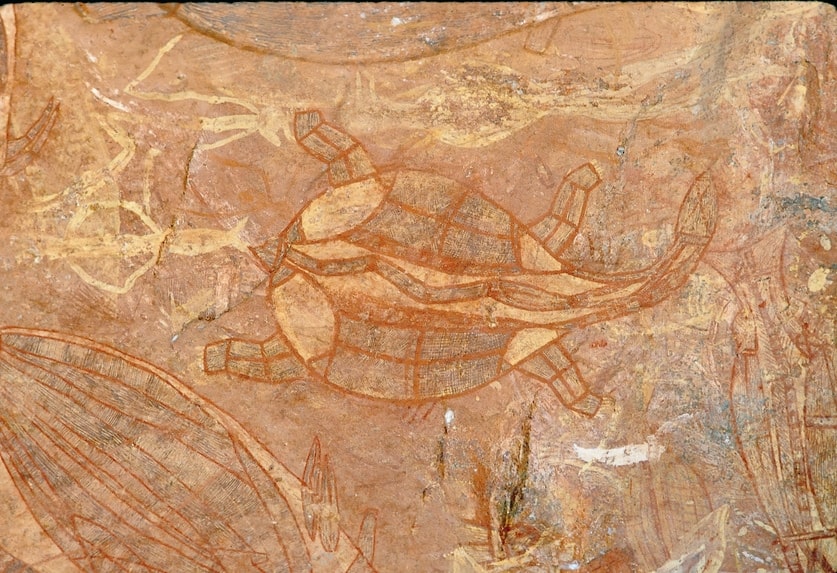
The oldest Stone Age art in Australia that has been carbon-dated is the Nawarla Gabarnmang Rock Shelter charcoal drawing (26,000 BCE) in Arnhem Land, Northern Territory. Other aboriginal rock painting from the Pre-Estuarine period is believed to be older – from about 30,000 BCE, but this has not been scientifically confirmed. Among the most distinctive pictures are the stick-like images of the Dynamic Figure tradition – often shown as being involved in hunting and other activities – and the famous the so-called “X-ray” pictures. These rock paintings also include images of extinct animals (like the Thylacine, or Tasmanian tiger) and mysterious living entities with human and other features.
There are several accessible galleries of cave painting at Ubirr, including the sacred Rainbow Serpent Gallery.
Burrup Peninsula Rock Art
Burrup Peninsula (also known as Murujuga), situated in the Pilbara area of Western Australia next to the Dampier Archipelago, is home to an estimated 1 million prehistoric rock engravings and is said to be the world’s largest collection of petroglyphs – some of which are believed to date back to the early phase of the Upper Paleolithic (c.30,000 BCE). However, most carbon dating tests have not yielded results earlier than the era of Mesolithic art (after 10,000 BCE). Its collection of standing stones, for instance, is the largest in Australasia.

Despite its enormous archaeological and anthropological significance, the area’s preservation appears to be under threat from the presence of large deposits of off-shore natural gas. In 2002 the International Federation of Rock Art Organizations (IFRAO) began a campaign to preserve what remains of the area.
Bradshaw Paintings
The Bradshaws – a name given to a unique style of rock art found in the Kimberley region of Western Australia by the cattle farmer Joseph Bradshaw in 1891 – are part of a huge expanse of prehistoric Kimberley rock art, estimated to encompass more than 100,000 sites spread over 50,000 square kilometres of territory.
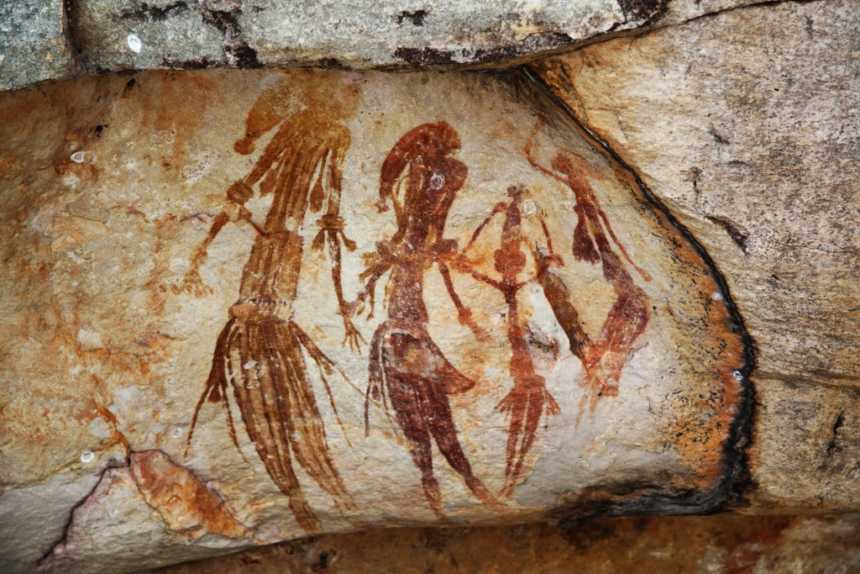
Known to be at least 17,000 years old, the Bradshaw rock paintings are assumed to have been created by indigenous Australian artists. However, the late Dr Grahame Walsh – a leading Bradshaw scholar – claimed that the Bradshaws were painted by people who predated the main aboriginal culture. This viewpoint has been firmly quashed by archaeological evidence.
Known for their brightly colored imagery, a large number of the ancient rock paintings have been colonized by a black fungus (Chaetothyriales) whose presence makes the art extremely difficult to date with any precision.
Bradshaw rock paintings depict human figures, usually wearing a variety of ceremonial clothes/accessories, like headdresses, skirts, armlets, tassels and sashes. Brushstrokes in these Bradshaws can be extremely fine – as tiny as 1 millimetre in width – which suggests the use of implements like feather quills.
Sydney Rock Engravings
A fine example of aboriginal Neolithic art, these meticulously crafted prehistoric engravings of people, animals and ideograms – carved in the sandstone around Sydney, New South Wales – are characterized by their “simple figurative” style, an iconographical style which dates back to the end of the Mesolithic era, about 5,000 BCE.
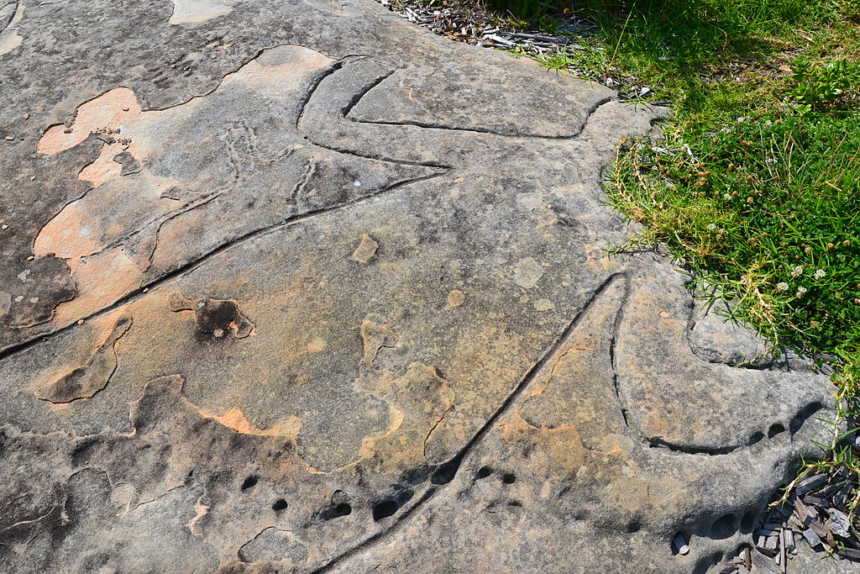
Thousands of these rock carvings are known to exist in the Sydney region, although many finds are kept secret to protect the sites, many of which are seen as sacred by Australian aborigines. Since aboriginal settlement of the Blue Mountains dates back much earlier, to about 20,000 BCE, earlier sites of this parietal art may yet be discovered in the Sydney area.
Collections of Aboriginal Art
Although indigenous Australian artworks can be seen in some of the world’s best art museums, only a tiny number of venues are dedicated exclusively to this form of art. They include: The Museum for Australian Aboriginal Art at Neuchatel, Switzerland; the Museum of Contemporary Aboriginal Art at Utrecht, The Netherlands; and the Kluge-Ruhe Aboriginal Art Collection of the University of Virginia, USA.
Almost all serious arts museums in Australia contain a wide range of modern and contemporary works by indigenous artists. Such venues include: the National Gallery of Australia (NGA) in Canberra; the National Gallery of Victoria (NGV) in Melbourne; the Art Gallery of South Australia (AGSA) in Adelaide; the Art Gallery of New South Wales (AGNSW) in Sydney; the Queensland Art Gallery (QAG) in Brisbane; and the Art Gallery of Western Australia (AGWA) in Perth.


